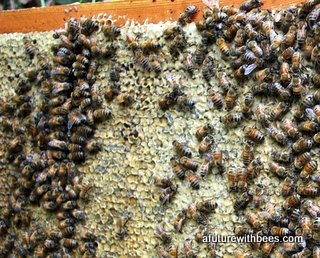September is an odd month for beekeepers. The weather is still warm, and it feels like we should be doing something - but there is not much for us to do. It is too late to raise queens or make splits. We are not adding supers because the nectar flow is over. If we have harvested honey, we are starting to condense the hives for the winter. But, we cannot condense them too much too early. As usual, it can be difficult to strike just the right balance.
We want to condense the hives and get them to winter configuration, but if we do it too soon, we can actually force fall swarms. And then everybody loses; The bees, the Beekeeper, and all of those who benefit from hive products. Because a fall swarm as no chance of surviving.
The queen has already reduced her rate of egg laying and the hive will not seem as populous as it was two months ago. There will be less drones and fewer frames of brood. The lower box will contain a lot of pollen. Hopefully the upper box contains a lot of honey. While the colony is still very active, they are not bringing in as much nectar or honey as in the past months. As a matter of fact, most hives will neither gain or lose significant weight this month.
The colonies' activity level and configuration changes from month-to-month. This is important to remember. I often get calls from beekeepers who are concerned because the hive does not look like it did a month ago or, like the picture they have in their head. That picture is often static and they expect the hive to look the same all the time. Sort of like expecting your child to look the same all the time - it just doesn't happen that way. A beehive is constantly changing from season to sea-son and month to month. It takes practice to adopt a mentality of thinking what a beehive should look like according to this season's weather and the current time of year. I have worked cultivate a practice of thinking about what the hive should look like before I open it up.
Lessons I Have Learned:
- Feed the hives that are a little underweight. But do not feed the strong ones because they will plug the brood nest and are likely to throw a fall swarm. And don't feed the really weak ones. They will not survive even if you feed them, so it is a waste of time and money.
- The adage "take your winter losses in the fall"applies to these really weak colonies. While it is still a little early in September to start combining these weak hives that won't overwinter, we will most likely do that in October. Instead of feeding weak hives and watching them die over the winter anyway, I've learned to real-locate those resources by combining them with some of the moderate to strong hives. Reallocate the resources instead of losing them.
- Having foundation on hives this late in the year will result in ruined foundation. 90% of the hives will not draw foundation this late in the year even if they are fed. A few will, but not most of them. Instead of drawing the foundation, they chew holes in it and muck it up.
- The small hive beetle population is peaking in August and September. It is not uncommon to see 30 or 50 small hive beetles in a hive. If the hive is strong they can handle the SHB no problem. It's hard, but we have to let the bees handle their own problems. And, as most parents learn, they do very well without us.
- Which brings me to my next lesson I have painfully learned. Do not overwork a hive in the fall. Getting into the hive too often messes up their rhythm and "jailbreaks" the SHB. There really isn't much the bees need from me in these months. I have had to learn to curb my need to "help them". Getting into the hives more often than every three or four weeks hurts them more than it helps them at this time of year.
- Wait until at least mid October for any serious condensing of the hive. We still have a lot of hot days and condensing them too much too early has caused me serious problems in the past. It is heartbreaking to see a hive go into swarming mode in the fall because we have artificially cramped them.
